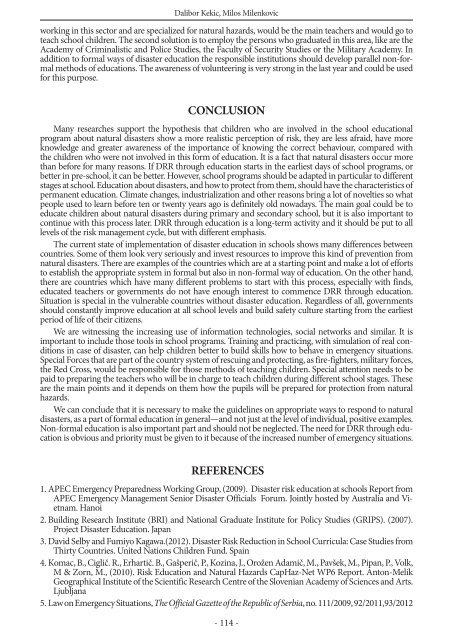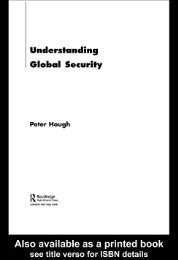Rajs_2015_Tom_2
Rajs_2015_Tom_2
Rajs_2015_Tom_2
Create successful ePaper yourself
Turn your PDF publications into a flip-book with our unique Google optimized e-Paper software.
Dalibor Kekic, Milos Milenkovic<br />
working in this sector and are specialized for natural hazards, would be the main teachers and would go to<br />
teach school children. The second solution is to employ the persons who graduated in this area, like are the<br />
Academy of Criminalistic and Police Studies, the Faculty of Security Studies or the Military Academy. In<br />
addition to formal ways of disaster education the responsible institutions should develop parallel non-formal<br />
methods of educations. The awareness of volunteering is very strong in the last year and could be used<br />
for this purpose.<br />
CONCLUSION<br />
Many researches support the hypothesis that children who are involved in the school educational<br />
program about natural disasters show a more realistic perception of risk, they are less afraid, have more<br />
knowledge and greater awareness of the importance of knowing the correct behaviour, compared with<br />
the children who were not involved in this form of education. It is a fact that natural disasters occur more<br />
than before for many reasons. If DRR through education starts in the earliest days of school programs, or<br />
better in pre-school, it can be better. However, school programs should be adapted in particular to different<br />
stages at school. Education about disasters, and how to protect from them, should have the characteristics of<br />
permanent education. Climate changes, industrialization and other reasons bring a lot of novelties so what<br />
people used to learn before ten or twenty years ago is definitely old nowadays. The main goal could be to<br />
educate children about natural disasters during primary and secondary school, but it is also important to<br />
continue with this process later. DRR through education is a long-term activity and it should be put to all<br />
levels of the risk management cycle, but with different emphasis.<br />
The current state of implementation of disaster education in schools shows many differences between<br />
countries. Some of them look very seriously and invest resources to improve this kind of prevention from<br />
natural disasters. There are examples of the countries which are at a starting point and make a lot of efforts<br />
to establish the appropriate system in formal but also in non-formal way of education. On the other hand,<br />
there are countries which have many different problems to start with this process, especially with finds,<br />
educated teachers or governments do not have enough interest to commence DRR through education.<br />
Situation is special in the vulnerable countries without disaster education. Regardless of all, governments<br />
should constantly improve education at all school levels and build safety culture starting from the earliest<br />
period of life of their citizens.<br />
We are witnessing the increasing use of information technologies, social networks and similar. It is<br />
important to include those tools in school programs. Training and practicing, with simulation of real conditions<br />
in case of disaster, can help children better to build skills how to behave in emergency situations.<br />
Special Forces that are part of the country system of rescuing and protecting, as fire-fighters, military forces,<br />
the Red Cross, would be responsible for those methods of teaching children. Special attention needs to be<br />
paid to preparing the teachers who will be in charge to teach children during different school stages. These<br />
are the main points and it depends on them how the pupils will be prepared for protection from natural<br />
hazards.<br />
We can conclude that it is necessary to make the guidelines on appropriate ways to respond to natural<br />
disasters, as a part of formal education in general—and not just at the level of individual, positive examples.<br />
Non-formal education is also important part and should not be neglected. The need for DRR through education<br />
is obvious and priority must be given to it because of the increased number of emergency situations.<br />
REFERENCES<br />
1. APEC Emergency Preparedness Working Group, (2009). Disaster risk education at schools Report from<br />
APEC Emergency Management Senior Disaster Officials Forum. Jointly hosted by Australia and Vietnam.<br />
Hanoi<br />
2. Building Research Institute (BRI) and National Graduate Institute for Policy Studies (GRIPS). (2007).<br />
Project Disaster Education. Japan<br />
3. David Selby and Fumiyo Kagawa.(2012). Disaster Risk Reduction in School Curricula: Case Studies from<br />
Thirty Countries. United Nations Children Fund. Spain<br />
4. Komac, B., Ciglič. R., Erhartič. B., Gašperič, P., Kozina, J., Orožen Adamič, M., Pavšek, M., Pipan, P., Volk,<br />
M & Zorn, M., (2010). Risk Education and Natural Hazards CapHaz-Net WP6 Report. Anton-Melik<br />
Geographical Institute of the Scientific Research Centre of the Slovenian Academy of Sciences and Arts.<br />
Ljubljana<br />
5. Law on Emergency Situations, The Official Gazette of the Republic of Serbia, no. 111/2009, 92/2011,93/2012<br />
- 114 -
















